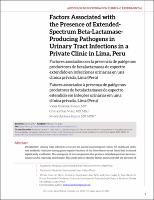Mostrar el registro sencillo del ítem
Factors associated with the presence of extended spectrum Beta-Lactamase producing pathogens in urinary tract infections in a private clinic in Lima, Peru
| dc.contributor.advisor | Apolaya Segura, Moises Alexander | |
| dc.contributor.advisor | Díaz Vélez, Cristian | |
| dc.contributor.author | Apolaya Segura, Moisés | |
| dc.contributor.author | Díaz Vélez, Cristian | |
| dc.contributor.author | Remenik Zarauz, Vania | |
| dc.date.accessioned | 2020-09-04T00:53:52Z | |
| dc.date.available | 2020-09-04T00:53:52Z | |
| dc.date.issued | 2020 | |
| dc.identifier.issn | 1692-7273 | |
| dc.identifier.uri | https://hdl.handle.net/20.500.12692/46095 | |
| dc.description.abstract | Introduction: Urinary tract infections (utis) are the second most frequent reason for healthcare visits, and antibiotic resistance among gram-negative bacteria of the Enterobacteriaceae family has increased significantly worldwide. The emergence of microorganisms that produce extended-spectrum beta-lactamase (esbl) is especially problematic. This study aims to identify factors associated with the presence of uti caused by esbl-producing pathogens. Material and methods: An analytical cross-sectional study was conducted, and the urine culture database from a private healthcare clinic was analyzed. Factors possibly associated with the appearance of utis due to esbl-producing pathogens were analyzed, including sex, age, number of hospitalizations, and previous utis. Results: A total of 1405 positive urine cultures were studied, 85.48% of which belonged to women. The mean age of the subjects was 39.98±24.51 years, 24.13% of whom were over 60 years old. Of these, 55.56% had been attended on an outpatient basis. Almost half (49.18%) of the cultures tested positive for esbl-related uti, 96.58% of which had not presented with a previous uti. A statistically significant association was found between sex and the development of uti caused by esbl-producing microorganisms (p = 0.007), with the male sex having the highest association (prevalence ratio, 1.224; 95% confidence interval: 1.035–1.448). In addition, age, number of previous hospitalizations, and prior intensive care unit admissions also showed associations with uti development. No association was found with the presence of previous utis. Conclusion: A high frequency of utis were esbl-related, and the factors associated with esbl-related utis were male sex, age >60, and previous hospitalizations. | en_US |
| dc.description.uri | Trabajo de investigación | es_PE |
| dc.format | application/pdf | es_PE |
| dc.language.iso | eng | es_PE |
| dc.publisher | Universidad César Vallejo | es_PE |
| dc.relation | info:eu-repo/semantics/article | es_PE |
| dc.relation.ispartofseries | Revista Ciencias de la Salud;18(2):1-11 | |
| dc.rights | info:eu-repo/semantics/openAccess | es_PE |
| dc.rights.uri | https://creativecommons.org/licenses/by/4.0/ | es_PE |
| dc.source | Repositorio Institucional - UCV | es_PE |
| dc.source | Universidad César Vallejo | es_PE |
| dc.subject | Infección del tracto urinario | es_PE |
| dc.subject | Betalactamasa | es_PE |
| dc.subject | Resistencia antibiótica | es_PE |
| dc.title | Factors associated with the presence of extended spectrum Beta-Lactamase producing pathogens in urinary tract infections in a private clinic in Lima, Peru | es_PE |
| dc.title.alternative | Factores asociados con la presencia de patógenos productores de betalactamasas de espectro extendido en infecciones urinarias en una clínica privada, Lima (Perú) | es_PE |
| dc.title.alternative | Fatores associados à presença de patógenos produtores de betalactamases de espectro estendido em infeções urinárias em uma clínica privada, Lima (Peru) | es_PE |
| dc.type | info:eu-repo/semantics/monograph | es_PE |
| thesis.degree.grantor | Universidad César Vallejo. Facultad de Ciencias de la Salud | es_PE |
| dc.description.sede | Trujillo | es_PE |
| dc.description.lineadeinvestigacion | Enfermedades Infecciosas y Transmisibles | es_PE |
| dc.description.peerreview | Revisión por pares | es_PE |
| dc.identifier.doi | https://doi.org/10.12804/revistas.urosario.edu.co/revsalud/a.9255 | |
| renati.level | https://purl.org/pe-repo/renati/level#tituloProfesional | es_PE |
| renati.type | https://purl.org/pe-repo/renati/type#trabajoDeInvestigacion | es_PE |
| dc.subject.ocde | https://purl.org/pe-repo/ocde/ford#3.01.00 | es_PE |
| dc.relation.isPartOf | urn:issn:1692-7273 | es_PE |
Ficheros en el ítem
Este ítem aparece en la(s) siguiente(s) colección(es)
-
Trujillo [93]


